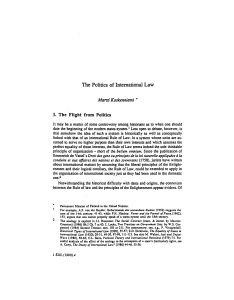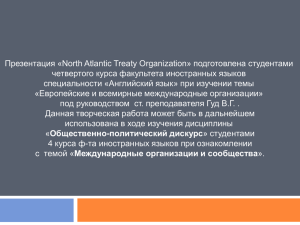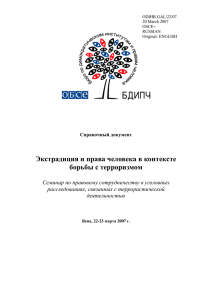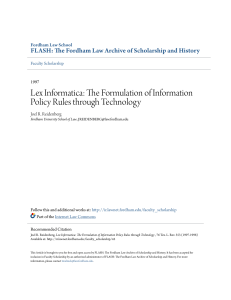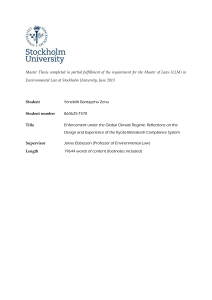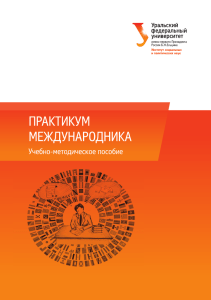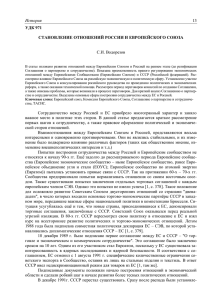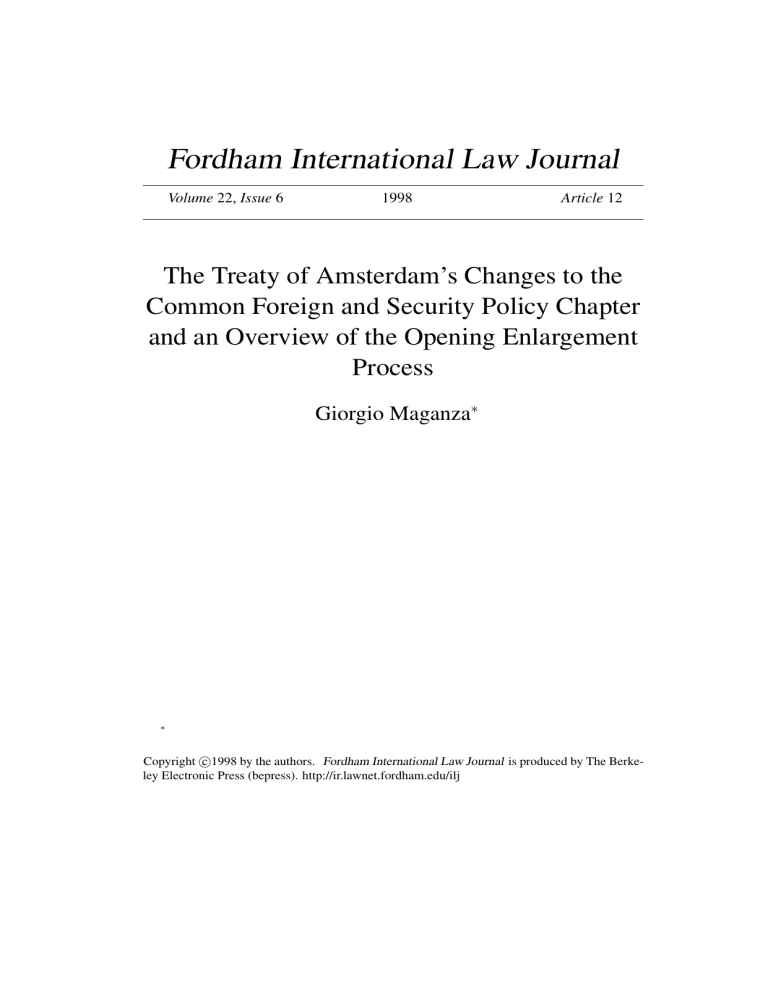
Fordham International Law Journal Volume 22, Issue 6 1998 Article 12 The Treaty of Amsterdam’s Changes to the Common Foreign and Security Policy Chapter and an Overview of the Opening Enlargement Process Giorgio Maganza∗ ∗ Copyright c 1998 by the authors. Fordham International Law Journal is produced by The Berkeley Electronic Press (bepress). http://ir.lawnet.fordham.edu/ilj The Treaty of Amsterdam’s Changes to the Common Foreign and Security Policy Chapter and an Overview of the Opening Enlargement Process Giorgio Maganza Abstract The European Union (“Union” or “EU”) is an important actor in the international arena. The Union behaves and acts as a political entity towards the outside world and it is perceived as such. That is certainly the case for international economic relations, where the European Community (“EC” or “Community”) has played a significant role as a major partner in multilateral negotiations for several years now. It is more frequently the case with respect to foreign policy matters, as a result of the choice made by the signatories to the Maastricht Treaty (“Treaty on European Union” or “TEU”) in which the signatories decided to give the Union the means to speak with one voice in world affairs and to conduct effective external action that would not be limited to economic and trade relations. Against this background, the purpose of this Essay is twofold: first, to provide a summary account of the main changes to the common foreign and security policy (“CFSP”) chapter resulting from the Treaty of Amsterdam (or “Treaty”), and second, to sketch a very general view of the opening enlargement process. THE TREATY OF AMSTERDAM'S CHANGES TO THE COMMON FOREIGN AND SECURITY POLICY CHAPTER AND AN OVERVIEW OF THE OPENING ENLARGEMENT PROCESS Giorgio Maganza* INTRODUCTION The European Union ("Union" or "EU") is an important actor in the international arena. The Union behaves and acts as a political entity towards the outside world and it is perceived as such. That is certainly the case for international economic relations, where the European Community ("EC" or "Community") has played a significant role as a major partner in multilateral negotiations for several years now. It is more frequently the case with respect to foreign policy matters, as a result of the choice made by the signatories to the Maastricht Treaty' ("Treaty on European Union" or "TEU") in which the signatories decided to give the Union the means to speak with one voice in world affairs and to conduct effective external action that would not be limited to economic and trade relations. The provisions of Title V of the Treaty on European Union accordingly set out the objectives of the Union's common foreign and security policy 2 and provided the instruments to carry this policy out. Of course, when referring to a union's foreign policy, one may naturally tend to think in terms of a state's foreign policy. That would be misleading and a cause for disappointment, in view of what some may regard as poor achievements of the Union's policy in foreign affairs. If it is not, or not yet, a fullyfledged foreign policy, however, the EU common foreign and * Legal Advisor to the Legal Service of the Council of the European Union. Member of the Task Force for the Intergovernmental Conference that negotiated and adopted the Treaty of Amsterdam. The views expressed in this paper are the author's personal views and do no in any way commit the Council of the European Union. 1. See Treaty on European Union, Feb. 7, 1992, O.J. C 224/1 (1992), [1992] 1 C.M.L.R. 719 [hereinafter TEU] (amending Treaty establishing the European Economic Community, Mar. 25, 1957, 298 U.N.T.S. 11 [hereinafter EEC Treaty], as amended by Single European Act, O.J. L 169/1 (1987), [1987] 2 C.M.L.R. 741). 2. See TEU, supra note 1, tit. V, O.J. C 224/1, at 94 (1992), [1992] 1 C.M.L.R. at 730. S174 1999] CFSP AND ENLARGEMENT S175 security policy certainly amounts to more than what its reputation would suggest. The launching, in recent weeks,' of the process of enlargement to the Eastern and Central European countries and to Cyprus is a timely example of the Union's political will to face up to its responsibilities on the European continent. It also provides further evidence that the Union continues, in spite of euroscepticism, to assert itself as a pole of attraction for the outside world. For a club that is the subject of recurrent criticism, it is not such a bad score, after all, that so many countries keep asking to join up. Against this background, the purpose of this Essay is twofold: first, to provide a summary account of the main changes to the common foreign and security policy ("CFSP") chapter resulting from the Treaty of Amsterdam 4 (or "Treaty"), and second, to sketch a very general view of the opening enlargement process. I. THE EU COMMON FOREIGN AND SECURITY POLICY AFTER THE TREATY OF AMSTERDAM The Treaty of Amsterdam, while confirming the choice 3. The paper, based on the presentation made at Fordham University School of Law on February 26, 1998, entitled The European Union in the International Arena, has been updated to April 30, 1998, in order to take account of developments in the enlargement process that have occurred subsequent to the former date. 4. Treaty of Amsterdam amending the Treaty on European Union, the Treaties establishing the European Communities and certain related acts, Oct. 2, 1997, O.J. C 340/1 (1997) (not yet ratified) [hereinafter Treaty of Amsterdam]. The text of the Treaty of Amsterdam (or the "Treaty") appears in OJ. C 340 of November 10, 1997, together with the text of the Final Act adopted by the Intergovernmental Conference. Article 1, point 10 of the Treaty of Amsterdam provides that the present Title V of the Treaty on European Union ("TEU") shall be replaced by new provisions that it reproduces in a fully consolidated version. See Treaty of Amsterdam, supra, art. 1(10), OJ. C 340/1, at 9 (1997) (replacing tit. V of TEU); Consolidated version of the Treaty on European Union, tit. V, O.J. C 340/2, at 155-62 (1997), 37 I.L.M. 67, 70-73 (not yet ratified) [hereinafter Consolidated TEU] (tit. V of TEU), incorporatingchanges made &y Treaty of Amsterdam, supra. By virtue of the Treaty of Amsterdam, articles of the TEU will be renumbered in the Consolidated version of the Treaty on European Union. See Treaty of Amsterdam, supra, art. 12, O.J. C 340/1, at 78-79 (1997). For a general view of the content of the Treaty, see Sally Langrish, The Treaty of Amsterdam: Selected Highlights, 23 EUR. L. REv. 3 (1998); Koen Lenaerts & Eddy De Smijter, Le Traitj d' Amsterdam, JOURNAL DES TRIBUNAUX-DROIT EUROPPEN, Feb. 1998, at 25; The Treaty of Amsterdam: Text and Commentary (Andrew Duff ed., 1997); Peter Ludlow, A View from Brussels: A Quarterly Commentary on the EU (Center or Eur. Pol'y Stud., Brussels, Belgium), July 1997; Pierre Des Nerviens, Les relations extbrieures, 4 REVUE TRiMESTRIELLE DE DROIT EUROPVEN 93 (1997). S176 FORDHAMINTERNATIONALLAWJOURNAL [Vol. 22:$174 made in Maastricht, improves upon the mechanisms available to the Union to act effectively in foreign policy matters. Clearly, such mechanisms, however developed they may be, cannot by themselves create a policy that requires a political will to act in common.5 This consideration should be taken into account when assessing the implementation of the CFSP chapter. In considering possible amendments to the provisions on the CFSP, the main concerns have been that of improving the decisionmaking and the implementation of the CFSP and that of allowing greater effectiveness and visibility to the Union's action. The Treaty of Amsterdam provides for an enhanced role of the European Council. It will be for the European Council not only to define the principles of and general guidelines for the CFSP, but also to "decide on common strategies to be implemented by the Union in areas where the Member States have important interests in common."6 Decision-making power is thus conferred upon the European Council.7 Under the new provisions, the Council is to act by a qualified majority whenever it makes a decision on the basis of a common strategy previously decided by the European Council.8 This requirement should allow for greater use of qualified majority 5. In its 1995 Report on the functioning of the Treaty on European Union, prepared with a view to the Reflection Group and to the Intergovernmental Conference ("IGC"), the Council stated the following: The first application of the provisions on the CFSP was the subject of particularly close appraisal, including appraisal by the public, among whom the CFSP had at the same time raised many expectations (as regards its potential) and called forth a great deal of criticism (in view of its achievements). Both the expectations and the criticisms were, no doubt, sometimes exaggerated; the provisions of the Treaty cannot alone provide ready-made solutions to problems, but only the means to tackle them. The political will to act is a determining factor in the proper use of the instruments of the Treaty. COUNCIL OF THE EUROPEAN UNION, REPORT ON THE FUNCTIONING OF THE TREATv ON 29, 56 (1995). 6. See Treaty of Amsterdam, supra note 4, art. 1(10), O.J. C 340/1, at 10 (1997) (replacing art. J.3(2) of TEU); Consolidated TEU, supra note 4, art. 13(2), O.J. C 340/ 2, at 156 (1997), 37 I.L.M. at 70 (specifying that common strategies shall set out their objectives, duration, and means to be made available). 7. As a consequence, the Commission, whose President is a member of the European Council according to Article D of the TEU, will be formally committed by European Council decisions. See TEU, supra note 1, art. D, O.J. C 224/1, at 5 (1992), [1992] 1 C.M.L.R. at 728. 8. See Treaty of Amsterdam, supra note 4, art. 1 (10), O.J. C 340/1, at 14 (1997) (inserting art. J.13(2), para. 1 into TEU); Consolidated TEU, supra note 4, art. 23(2), para. 1, O.J. C 340/2, at 160 (1997), 37 I.L.M. at 72 (art. J.13(2), para. 1 of TEU). EUROPEAN UNION 1999] CFSP AMD ENLARGEMENT S177 voting for implementing decisions whereas unanimity would remain the rule for the main policy decisions. Thus, an enhanced and more direct role of the European Council in CFSP decisionmaking could result in making this process more effective. Qualified majority voting in the Council will also be the rule for any decision implementing a joint action or a common position.9 The logic of the new provisions is that majority decisions should be politically acceptable whenever they come to be taken within the framework of another upstream decision, which will have been taken previously, either in the form of a common strategy defined by the European Council or in the form of a joint action or a common position unanimously adopted by the Council. Moreover, a safety net has been established through the possibility for a member of the Council to oppose the adoption of a decision for "important and stated reasons of national policy."10 The maintaining of unanimity as the voting rule for all main CFSP decisions has been combined with the possibility of constructive abstention, allowing a Member State to let a decision be taken while not being obliged to apply it." This combination is 9. See Treaty of Amsterdam, supra note 4, art. 1(10), O.J. C 340/1, at 14 (1997) (inserting art. J.13(2), para. 1 into TEU); Consolidated TEU, supra note 4, art. 23(2), para. 1, O.J. C 340/2, at 160 (1997), 37 I.L.M. at 72 (art. J.13(2), para. 1 of TEU). At present, this is possible only when the Council, in adopting ajoint action, has explicitly defined matters on which decisions are to be taken by a qualified majority. 10. See Treaty of Amsterdam, supra note 4, art. 1(10), O.J. C 340/1, at 15 (1997) (inserting art. J.13(2), para. 2 into TEU); Consolidated TEU, supra note 4, art. "23(2), para. 2, O.J. C 340/2, at 160 (1997), 37 I.L.M. at 72 (art. J.13(2) of TEU). This provision specifies, however, that the Council, acting by a qualified majority, may still request that the matter be referred to the European Council for decision by unanimity. This provision, which is regarded by some as reviving the 1966 "Luxembourg compromise," The Treaty of Amsterdam: Neither a Bang nor a Whimper, 34 COMMON MKT. L. REV. 767 (1997), and which has also been used in the procedure for authorizing closer cooperation injustice and Home Affairs, Treaty of Amsterdam, supra note 4,art. 1(11), Oj. C 340/1, at 21 (1997) (inserting art. K.12(2), para. 2 into TEU); Consolidated TEU, supra note 4, art. 40(2), para. 2, O.J. C 340/2, at 167 (1997), 37 I.L.M. at 76 (art. K12(2), para. 2 of TEU), seems unlikely to be resorted to often, given the conditions for its application. 11. See Treaty of Amsterdam, supra note 4, art. 1(10), O.J. C 340/1, at 14 (1997) (inserting art. J.13(l), para. 2 into TEU); Consolidated TEU, supra note 4, art. 23(1), para. 2, O.J. C 340/2, at 160 (1997), 37 I.L.M. at 72 (art.J.13(1), para. 2 of TEU). The Member State thus abstaining would accept, however, that the decision commits the European Union ("Union" or "EU") and would accordingly refrain from any action likely to conflict with or to impede EU action based on that decision. If the members of the Council qualifying their abstention in such a way represent more than one-third of the weighted votes, the decision may not be adopted. S178 FORDHAMINTERNATIONAL LAWJOURNAL [Vol. 22:$174 intended to reduce the risk of deadlock. Unanimity will remain 12 the rule for decisions having military or defense implications. While the Presidency will continue to play its role of representing the Union in matters coming within the CFSP and to be responsible for the implementation of CFSP decisions, 3 the visibility of the Union will be strengthened through the establishment of a High Representative, who will be the Secretary-General of the Council and will have the task of assisting the Council in matters coming within the scope of the CFSP, "in particular through contributing to the formulation, preparation, and implementation of policy decisions."' 4 The High Representative will also be responsible for a Policy Planning and Early Warning Unit, to be established within the General Secretariat of the Council with a view to monitoring developments in areas relevant to the CFSP and to providing policy assessments and options.' This addition is expected to offer a positive contribution to the Union's policy-making and to the consistency of its external action. On security and defense, the Treaty of Amsterdam amendments' 6 do not involve major changes in respect of the present situation, but they do reflect developments since the signing of 12. See Treaty of Amsterdam, supra note 4, art. 1(10), OJ. C 340/1, at 14-15 (1997) (inserting art. J.13(2) into TEU); Consolidated TEU, supra note 4, art. 23(2), OJ. C 340/2, at 160-61 (1997), 37 I.L.M. at 72-73 (art. J.13(2) of TEU). 13. See Treaty of Amsterdam, supra note 4, art. 1(10), O.J. C 340/1, at 13 (1997) (replacing art. J.8(1)-(2) of TEU); Consolidated TEU, supra note 4, art. 18(1)-(2), O.J. C 340/2, at 159 (1997), 37 I.L.M. at 72 (art. J.8(1)-(2) of TEU). 14. See Treaty of Amsterdam, supra note 4, art. 1(10), O.J. C 340/1, at 15 (1997) (inserting art. J.16 into TEU); Consolidated TEU, supra note 4, art. 26, O.J. C 340/2, at 161 (1997), 37 I.L.M. at 73 (art. J.16 of TEU); Treaty of Amsterdam, supra, art. 1(10), O.J. C 340/1, at 13 (1997) (replacing art.J.8(3) of TEU); Consolidated TEU, supra note 4, art. 18(3), O.J. C 340/2, at 159 (1997), 37 I.L.M. at 72 (art. J.8(3) of TEU). 15. Treaty of Amsterdam, supra note 4, Declaration on the establishment of a policy planning and early warning unit, O.J. C 340/1, at 132 (1997). The unit shall consist of personnel drawn from the General Secretariat of the Council, the Member States, the Commission, and the Western European Union. Id. 16. See Treaty of Amsterdam, supra note 4, art. 1(10), O.J. C 340/1, at 12-13 (1997) (replacing art. J.7 of TEU); Consolidated TEU, supra note 4, art. 17, O.J. C 340/2, at 157-58 (1997), 37 I.L.M. at 71 (art. J.7 of TEU); Treaty of Amsterdam, supra, Protocol on Article J.7 of the Treaty on European Union, O.J. C 340/1, at 92 (1997); see also Treaty of Amsterdam, supra, Declaration relating to Western European Union, O.J. C 340/1, at 125-31 (1997). According to Article 6 of the Protocol on the position of Denmark, that country does not participate in the elaboration and implementation of decisions of the Union having defense implications. Treaty of Amsterdam, supra, Protocol on the position of Denmark, art. 6, O.J. C 340/1, at 102 (1997). 1999] CFSP AND ENLARGEMENT S179 the Maastrict Treaty. In particular, the so-called "Petersberg tasks"-humanitarian and rescue tasks, peace-keeping tasks, and tasks of combat forces in crisis management, including peacemaking17-are now specifically mentioned as aspects of the Union's security policy, which all Member States, including the neutral ones, will contribute to implementing. 8 The CFSP includes the "progressive framing of a common defense policy": a door thus remains open to a common defense, although any decision in this respect, to be taken by the European Council, would require ratification by all Member States. The amended Treaty provisions also refer to cooperation between Member States in the field of armaments.1 9 As to relations between the Union and the Western European Union ("WEU"), the Intergovernmental Conference ("IGC") could not agree on the immediate integration of the WEU into the Union, which was strongly advocated by some, or on an integration timetable. Such integration, therefore, remains a rather distant objective, whose achievement is subject to the same procedure of a European Council decision to be approved by the Member States in accordance with their constitutional requirements. The budgetary provisions have been amended so that operational expenditure resulting from the implementation of the CFSP will be charged, as a rule, to the budget of the European Communities unless the Council unanimously decides otherwise and except for expenditure arising from operations having military or defense implications. In this case, expenditures will be charged to the Member States.2" An inter-institutional agreement was concluded, outside the IGC, between the European Parliament, the Council, and the Commission, under which it was agreed that CFSP operational expenditure will be treated as a non-compulsory expenditure, subject to detailed arrangements 17. The "Petersberg tasks" are named after the Western European Union declaration of Petersberg (near Bonn) of June 19, 1992. 18. See Treaty of Amsterdam, supra note 4, art. 1(10), O.J. C 340/1, at 12 (1997) (replacing art.J.7(2) of TEU); Consolidated TEU, supra note 4, art. 17(2), O.J. C 340/ 2, at 158 (1997), 37 I.L.M. at 71 (art. J.7(2) of TEU). 19. See Treaty of Amsterdam, supra note 4, art. 1(10), O.J. C 340/1, at 12 (1997) (replacing art. J.7(1), para. 4 of TEU); Consolidated TEU, supra note 4, art. 17(1), para. 4, OJ. C 340/2, at 158 (1997), 37 I.L.M. at 71 (art. J.7(1), para. 4 of TEU). 20. See Treaty of Amsterdam, supra note 4, art. 1(10), OJ. C 340/1, at 16 (1997) (inserting art. J.18(3) into TEU); Consolidated TEU, supra note 4, art. 28(3), OJ. C 340/2, at 162 (1997), 37 I.L.M. at 73 (art. J.18(3) of TEU). S180 FORDHAMINTERNATIONAL LAWJOURNAL [Vol. 22:S174 intended to limit the possibility for the European Parliament to control CFSP policy-making through its budgetary powers.2 1 Last but not least, the possibility has been explicitly recognized for the Union to negotiate and to conclude international agreements when necessary to implement the CFSP. Such agreements are to be negotiated by the Presidency and concluded by the Council acting unanimously.2 2 It is worth emphasizing the importance of this provision, which will put an end to the present unsatisfactory situation under which the Union cannot enter into legally binding international commitments in areas where Title V and VI of the TEU give it powers to act and where its partners expect it to act. This provision also provides further evidence for the existence of legal personality of the Union, as it may be derived from the Treaty provisions, although not explicitly conferred by them upon the Union, as well as from the continuing and convergent behavior of third parties vis-A-vis the Union itself. A realistic approach is essential when assessing the implementation of the Maastricht CFSP provisions, and the same will go for the new CFSP provisions when they come into force. The CFSP may amount to less than its name would suggest, but it is certainly more than what it is sometimes described to be and, as the above illustration of its institutions and procedures shows, certainly amounts to something more than the mere coordination of national policies. We are in an area that is at the core of national sovereignty and where well-rooted national traditions exist. A common approach in foreign policy matters cannot be created overnight and certainly not by the stroke of a pen. The 21. The text of the inter-institutional agreement appears in OJ. C 286, at 80 (1998). According to the budgetary procedure laid down in the Treaty establishing the European Community, which applies to the expenditure charged to the budget of the European Communities, the European Parliament has the last word on "non-compulsory expenditure"-i.e., expenditure not necessarily resulting from the Treaty or from the acts adopted thereunder-and the Council has the last word on "compulsory expenditure." See Treaty establishing the European Community, Feb. 7, 1992, art. 203, OJ. C 224/1, at 71 (1992), [1992] 1 C.M.L.R. 573, 703-06 [hereinafter EC Treaty], incorporatingchanges made by TEU, supra note 1. 22. See Treaty of Amsterdam, supra note 4, art. 1 (10), Oj. C 340/1, at 15 (1997) (inserting art. J.14 into TEU); Consolidated TEU, supra note 4, art. 24, OJ. C 340/2, at 161 (1997), 37 I.L.M. at 73 (art. J.14 of TEU) (providing also that any Member State declaring that it has to comply with its constitutional requirements shall not be bound, although other members of Council may agree that agreement will apply provisionally to them). Article J.14 also applies to matters falling under Title VI. 1999] CMP AMD ENLARGEMENT S181 forging of a common foreign and security policy of the Union should be regarded as a learning process that must be given time to occur. II. THE PREPARATION AND THE OPENING OF THE ENLARGEMENT PROCESS A. The Context As was emphasized at the beginning, the Union is an important actor in the international arena, and it keeps on attracting applications for accession. The Union is now embarking on its fifth enlargement process since the European Communities were first created. It is indeed the second time that enlargement will take place on the basis of Article 0 of the TEU, that is to say, on the basis of applications to become a member of the Union as such.2 3 Before the entry into force of the Maastricht Treaty, applications were theoretically possible to each individual Community on the basis of separate provisions in each of the three Treaties establishing the European Communities,2 4 although in 23. Under Article 0 of the TEU, applications to become a member of the Union are submitted to the Council, which decides, after consulting the Commission, to open intergovernmental negotiations between the Member States of the Union and the candidate for admission. The outcome of the negotiations, including the conditions for admission of the candidate States, must be approved by the Council after receiving an opinion by the Commission and, since the entry into force of the Single European Act, the assent of the European Parliament. The application is then submitted for ratification by all the contracting States. TEU, supra note 1, art. 0, O.J. C 224/1, at 99 (1992), [1992] 1 C.M.L.R. at 739. The Treaty of Amsterdam has amended Article 0 to provide, as a new condition for applying to become a member of the Union, the respect for "the principles of liberty, democracy, respect for human rights and fundamental freedoms, and the rule of law," principles on which the Union is founded and which are common to the Member States, as the amended Article F(1) of the TEU recollects. See Treaty of Amsterdam, supra note 4, art. 1(15), O.J. C 340/1, at 24 (1997) (replacing art. 0, 2 of TEU); Consolidated TEU, supra note 4, art. 49, O.J. C 340/2, at 171 (1997), 37 I.L.M. at 78 (art. 0 of TEU); Treaty of Amsterdam, supra, art. 1(8), O.J. C 340/1, at 8 (1997) (amending art. F of TEU); Consolidated TEU, supra, art. 6, O.J. C 340/2, at 153 (1997), 37 I.L.M. at 69 (art. F of TEU). 24. See EC Treaty, supra note 1, art. 237, OJ. C 224/1, at 78 (1992), [1992] 1 C.M.L.R. at 716 (repealed at Maastricht); Treaty establishing the European Atomic Energy Community, Mar. 25, 1957, art. 205, 298 U.N.T.S. 167, 231; Treaty establishing the European Coal and Steel Community, Apr. 18, 1951, art. 98, 261 U.N.T.S. 140, 226. Negotiations with Austria, Norway, Finland, and Sweden, opened on February 1, 1993, before the entry into force of the TEU and on the basis of the three above-mentioned treaty provisions. The negotiations were subsequently converted, after the entry into force of the TEU on November 1, 1993, into negotiations on the basis of Article 0 of the TEU. S182 FORDHAMINTERNATIONALLAWJOURNAL [Vol. 22:$174 practice no "pick and choose" application was ever made, whereas now applications are only possible to become a member of the Union as such, covering all its constituent parts. The importance of this enlargement goes without saying. It will be by far the most important and challenging enlargement yet faced. It suffices to think of the number of countries involved in the process: twelve, that is to say, three times as many countries as were involved in the previous largest enlargement negotiations, which were the first and the fourth negotiations, each involving four countries.2 5 It also suffices to consider the size of the populations concerned, amounting to over one hundred million people, almost thirty percent of the total population of the fifteen Member States at present. One must further consider the extreme diversity of the social and economic situations involved,2 6 which is not matched by any of the previous enlargement contexts. For sure, the fifth enlargement of the Union is also the most challenging, especially when seen against the background of the return of democracy to the Central and Eastern European countries only a few years ago. In the words of the Madrid European Council, this enlargement is "both a political necessity and a historic opportunity for Europe" and "will ensure the stability and security of the continent."2 7 Which countries are candidates? They are the ten Eastern and Central European countries ("ECECs") that have concluded association "Europe Agreements" with the Union and that have applied for membership between 1994 and 1996,28 plus Cyprus 25. The first enlargement process involved Denmark, Ireland, Norway, and the United Kingdom; the second concerned Greece; the third involved the applications by Portugal and Spain; and the fourth involved four countries again: Austria, Finland, Norway, and Sweden. On the latest enlargement, see Roger J. Goebel, The European Union Grows: The ConstitutionalImpact of the Accession of Austria, Finland and Sweden, 18 FORDHAM INT'L LJ. 1092 (1995). 26. See the figures attached to European Commission, Agenda 2000: Fora Stronger and Wider Union, 5 E.U. BULL. Suppl. (1997) [hereinafter Agenda 2000]; Gfinter Burghardt & Fraser Cameron, The Next Enlargementof the European Union, 2 EUR. FOREIGN Aen. R~v. 7 (1997). 27. Madrid European Council, Conclusions of the Presidency, E.U. BULL., no. 12, at 9 (1995) [hereinafter Madrid Presidency Conclusions]. 28. The application dates are as follows: Hungary, March 31, 1994; Poland, April 5, 1994; Romania, June 22, 1995; Slovakia, June 27, 1995; Latvia, October 13, 1995; Estonia, November 24, 1995; Lithuania, December 8, 1995; Bulgaria, December 14, 1995; Czech Republic, January 17, 1996; Slovenia,June 10, 1996. On the Europe Agreements, see Marc Maresceau & Elisabetta Montaguti, The Relations Betwen the European Union and Central and Eastern Europe: A Legal Appraisal, 32 COMMON MKT. L. Rxv. 1327 1999] CFSP AND ENLARGEMENT S183 and Turkey, whose applications are older.2 9 Malta and Switzerland have been candidates for membership in the European Communities in the past, but they did not follow up on their applications.30 B. Preparationfor the Enlargement Process Concrete preparations for the enlargement process opened with the presentation by the Commission to the Council, in July 1997, of the so-called "Agenda 2000" package 31 together with its opinions on the applications by the ECECs.3 2 The Agenda 2000 communication deals with the policy reforms necessary to prepare the Union for enlargement. Agenda 2000 also provides the new financial framework for the period 2000-2006. 3 ' Drawing upon the individual opinions on the applications, Agenda 2000 recommends that negotiations be opened with five countriesHungary, Poland, Estonia, the Czech Republic, and Sloveniaand it suggests that an overall framework, or European Conference, be created to bring together the Member States and the European countries aspiring to join them within the Union. The debate on the enlargement of the Union to the East, and to the South, and on the enlargement's timetable, however, (1995). On the prospect for enlargement to the Eastern and Central European countries ("ECECs"), see Hans van den Broek, Preparingfor the Enlargement of the European Union, 8 EUR. Bus. J. 9 (1996). 29. Cyprus applied on July 4, 1990. Turkey applied on April 14, 1987. 30. Malta also applied shortly after Cyprus, on July 16, 1990. Malta has since withdrawn its application. Switzerland applied for membership in May 1992, but subsequently froze its application, following the negative outcome of its referendum on December 6, 1992, on the European Economic Area. 31. Agenda 2000, supra note 26. 32. The Commission's opinion on the individual applications by the ECECs are published as Supplements 6/97 to 15/97 to the E.U. Bulletin. See E.U. BULL., nos. 6-15 (1997). The Commission opinion on the Cyprus application, which was positive, was given on June 30, 1993. E.U. BULL., no. 6, at 100 (1993). The Commission's opinion on the Turkey application was given on December 17, 1989. While reiterating Turkey's eligibility for membership, the Commission concluded that further steps were necessary, both at the political and economic levels, before considering whether negotiations for the admission of Turkey to the European Community could be launched. 22 E.C. BULL., no. 12, at 88, 2.2.37 (1989). 33. Welcoming the Commission communication, the Luxembourg European Council confirmed "the need to ensure in advance of enlargement that the Union is in a position to cope with it under the best conditions by making the adjustments deemed necessary to its policies and their financing." Luxembourg European Council, Conclusions of the Presidency, E.U. BULL., no. 12, at 8, 37 (1997) [hereinafter Luxembourg Presidency Conclusions]. S184 FORDHAMINTERNATIONALLAWJOURNAL [Vol. 22:S174 had already been going on for some time. In particular, the European Council had set out, in June 1993, the main requirements for the accession of the ECECs to the Union. 34 Thereafter, in December 1995, the European Council agreed that the accession negotiations would start after the conclusion of the recent IGC. The successful outcome of the IGC negotiations in June 1997 thus cleared the way for the launching of the enlargement process. The necessary decisions to that effect were taken by the European Council in Luxembourg on December 12-13, 1997. Firstly, the European Council decided that the overall enlargement process would be "a comprehensive, inclusive and ongoing process, which will take place in stages; each of the applicant States will proceed at its own rate, depending on its degree of preparedness. '36 Following the Commission's recommendation, the European Council decided to set up a "European Conference" as "a multilateral forum for political consultation" to bring together Member States of the Union and "the European States aspiring to accede to it and sharing its values and internal and external objectives. ' 37 Second, the European Council decided to launch an accession process that would comprise the ten ECECs and Cyprus, all being "destined to join the European Union on the basis of the same criteria" and participating in the process "on an equal footing. '38 Third, the European Council, in light of the recommendations by the Commission, decided to open negotiating conferences with five ECECs-Hungary, Poland, Estonia, the Czech Republic, and Slovenia-plus Cyprus. The European Council, however, clearly wished to set its de34. Copenhagen European Council, Conclusions of the Presidency, E.U. BULL., no. 6, at 7 (1993). Membership requires that the candidate country has achieved stability of institutions guaranteeing democracy, the rule of law, human rights and respect for and protection of minorities, the existence of a functioning market economy as well as the capacity to cope with competitive pressure and market forces within the Union. Membership presupposes the candidate's ability to take on the obligations of membership including adherence to the aims of political, economic and monetary union. Id. at 13. 35. Madrid Presidency Conclusions, supra note 27, at 18. 36. See Luxembourg Presidency Conclusions, supra note 33, at 8, 2. 37. Id. at 9, 4-9. 38. Id. at 9. 19991 CFSP AND ENLARGEMENT S185 cision within an overall political and institutional context comprising all "ten plus one" candidate countries. Accordingly, it announced that the opening of the six intergovernmental negotiating conferences would be preceded by a ministerial meeting between the fifteen EU Member States and the applicant states-the ten Central and Eastern European applicant states and Cyprus-thus formally establishing a single framework for the launching of the accession process. The European Council agreed that, in this context, a regular assessment of the progress made by each individual applicant state would be carried out. The European Council also announced the main elements of an "enhanced pre-accession strategy," intended to enable all the applicant states to align themselves as far as possible on the Union acquis prior to accession.3 9 Alongside the Europe Agree- ments there will be increased pre-accession aid, and a new instrument has been created, called an "Accession Partnership," to mobilize all forms of assistance within a single framework.4" A specific pre-accession strategy has been tailored for Cyprus. As for Turkey, the European Council confirmed its eligibility for accession to the Union and, while considering that "political and economic conditions allowing accession negotiations to be envisaged are not satisfied," drew up a specific strategy to bring Turkey closer to the Union, thus preparing it for accession.4 1 The European Council nevertheless recalled that strengthening the links with the Union also depends on Turkey's pursuit of political and economic reforms, its protection of 39. Id. at 13. 40. See Council Regulation No. 622/98 of 16 March 1998 on assistance to the applicant states in the framework of the pre-accession strategy, and in particular on the establishment of Accession Partnerships, Oj. L 85/1 (1998). The Accession Partnership is the instrument setting the priorities to be observed in preparing for accession and also setting the financial resources available for that purpose (which are the PHARE programme, focused on the reinforcement of administrative andjudicial capacity and on investments related to the adoption and application of the acquis; aid for agriculture; and a structural instrument, conceived along the lines of the Union's Cohesion Fund). The financial assistance is conditioned on compliance with the program for preparation to accession. On the basis of Regulation No. 622/98, the Council decided on March 30, 1998, on the principles, priorities, intermediate objectives, and conditions contained in the individual Accession Partnerships to be submitted to each applicant state. On the Accession Partnerships, see Agenda 2000, supra note 26, at 53. 41. Luxembourg Presidency Conclusions, supra note 33, at 11, j 31-36. Building upon the Association Agreement and the Customs Union, the strategy should include in particular financial cooperation, the approximation of laws, and adoption of the Union acquis. S186 FORDHAMINTERNATIONAL LAWJO URNAL minorities, stable relations with Greece, and support for a political settlement in Cyprus. Turkey was due to participate in the European Conference that the European Council decided to set up. Displeased by the outcome of the Luxembourg European Council and what it perceived as a rebuff by the Union, however, it did not attend the Conference. C. The Opening of the Enlargement Process The opening meeting of the European Conference took place in London on March 12, 1998, at the level of Heads of State and Government. The Conference addressed questions of general concern to the participants, namely in the fields of common and foreign security policy, for example, the situation in Kosovo, justice and home affairs, for example, the fight against drugs trafficking and transnational organized crime, environment, and regional cooperation. The accession process was launched in Brussels on March 30, 1998. Twenty-six Foreign Affairs Ministers attended the meeting that set the framework for the "comprehensive, inclusive and ongoing process" decided upon three months earlier in Luxembourg. The President of the Council exposed the Union's position to the eleven candidate states, stressing that the accession process formed part of the overall enlargement process that had just seen the launch of the European Conference in London. The following day, March 31, 1998, saw the opening of six negotiating intergovernmental conferences, at the ministerial level, between the Member States of the Union and, respectively, Hungary, Poland, Estonia, the Czech Republic, Slovenia, and Cyprus. Each ministerial conference took note of opening statements, including the Union's position, presented by the U.K. Foreign Affairs Minister Cook, as President-in-Office of the Council, an address by Commissioner van den Broek, and the position of the candidate state. As agreed on March 31, the first meetings of the six conferences at the Deputy level were held on April 23-24, 1998. On that occasion, the specific details of the procedure for, and organization of, the negotiations such as frequency of meetings, documents, secretariat, and the preliminary indicative list of chapter headings, were also agreed upon.
